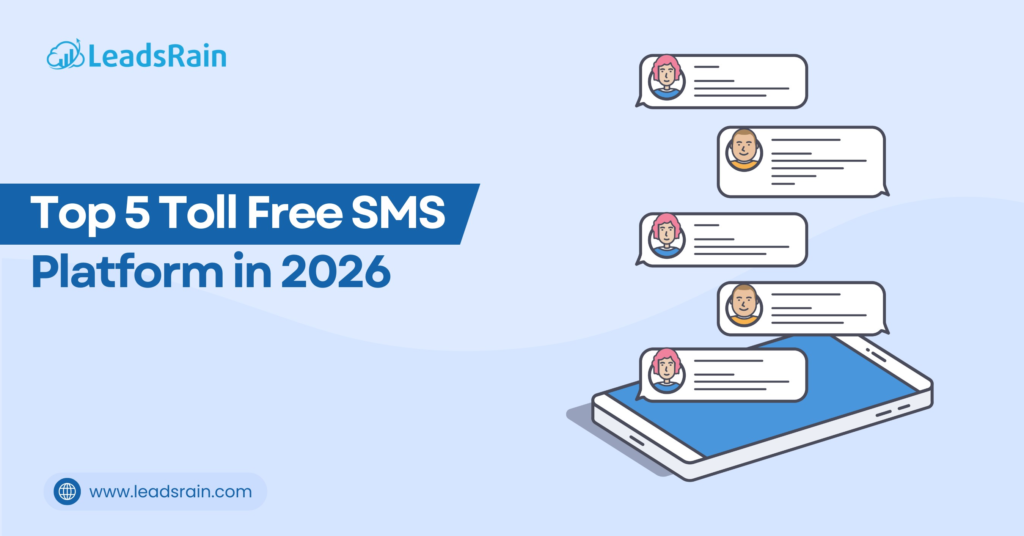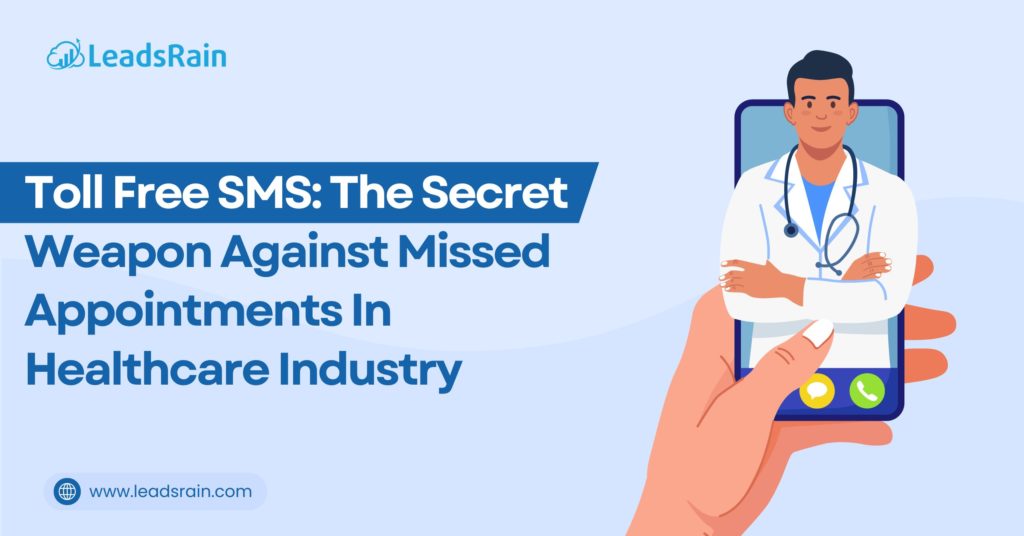Let’s be honest — getting customers to actually engage these days feels like pulling teeth.
You pour your heart into emails. You tweak your social posts. You even try cute GIFs. And what happens? Crickets. Or worse — an unsubscribe button clicked faster than you can say “personalized experience.”
But here’s the thing: while everyone’s busy fighting for attention in crowded inboxes and algorithm-controlled feeds, there’s one channel quietly killing it — SMS. And not just any SMS. We’re talking toll-free SMS. The kind that uses those familiar 800, 888, 877 numbers you’ve seen on TV commercials or the back of receipts. Yeah, those.
Customers already trust those numbers. They don’t stress about getting charged to text them. And they’re way more likely to hit reply when they see one pop up on their phone. Add in sky-high open rates (seriously — 98% within 3 minutes) and you’ve got yourself a golden ticket to cut through the noise.
In this piece, we’re breaking down why toll-free SMS is having a serious moment, how it stacks up against other options like 10DLC, and — most importantly — how to use it without annoying your customers (or getting blacklisted by carriers). Let’s get into it.
So… Why Is Everyone Suddenly Obsessed With Toll-Free SMS?
A few years ago, if you mentioned “texting customers,” people pictured sketchy coupon blasts or spammy political robo-texts. Not exactly the vibe brands want.
But things have changed — fast.
Carriers got serious about cracking down on shady messaging. Customers got savvier (and pickier). And businesses? Well, we got desperate for channels that actually work. Enter toll-free SMS — the sweet spot between professionalism, compliance, and real human connection.
Think about it: when your customer sees “Text HELP to 888-555-1234” — they don’t flinch. They don’t wonder if it’s a scam. They recognize it. Maybe they’ve even called that number before. That instant trust? Priceless.
Plus, with regulations like TCPA breathing down our necks, using a registered, carrier-vetted toll-free number isn’t just smart — it’s survival. Healthcare providers, banks, e-commerce giants, even your local HVAC company — they’re all jumping on board. Not because it’s trendy, but because it converts.
What Makes Toll-Free SMS So Damn Good for Customer Engagement?
Let’s cut to the chase. Why should you care? Here’s the real-deal, no-fluff breakdown:
Instant Credibility
Nobody texts back a random 10-digit number from Nowheresville, USA. But an 800 number? That’s “real business” energy. It signals you’re legit — which means customers are more likely to opt in, reply, and stick around.
Looks Like Real Conversations, Not Just Blasts
This isn’t a one-way street. Customers can ask questions, complain, praise you, or just say “LOL” — and you can respond in real time. That back-and-forth? That’s where loyalty is born.
Handles Heavy Traffic
Running a flash sale? Launching a new product? Need to blast 50K messages in 60 seconds? Toll-free SMS doesn’t choke. Most 10DLC numbers tap out at 1–10 messages per second. Toll-free? Try 50–100+. Big difference when timing is everything.
You Can Send More Than Just Text
Photos of the product they ordered? A quick video tutorial? A map to your nearest store? Yep — MMS is totally in play. And clickable links? Obviously. Make it visual. Make it useful.
No Gotcha Fees for Customers
“Toll-free” = free for them to text you. Period. Remove that tiny mental barrier, and watch engagement climb. Especially for support — people will ask way more questions if they’re not worried about their phone bill.
Plays Nice With the Rules
Carriers actually like toll-free numbers (once they’re registered). That means fewer messages lost to spam filters, better deliverability, and no midnight panic when your campaign gets throttled.
One Number to Rule Them All
Already using an 800 number for calls? Perfect. Now use it for texts too. Customers don’t have to remember a new number. You don’t have to manage two systems. Everyone wins.
Toll-Free SMS vs. 10DLC — Which One Actually Moves the Needle?
Look, 10DLC has its place. If you’re a local dentist sending appointment reminders to 200 patients, it’s probably fine. Cheap, simple, gets the job done.
But if you’re trying to build scalable, brand-safe, high-converting customer journeys? Nah. Here’s the real talk:
Perception:
10DLC looks like Joe’s Used Tires texting you from his personal cell. Toll-free looks like Amazon, Chase, or Delta. Which one are you?
Speed & Scale:
10DLC gets throttled HARD. Carriers limit how fast you can send — sometimes as low as 1 message per second. Toll-free? You’re flying. Perfect for flash sales, breaking news, or urgent alerts.
Spam Risk:
10DLC requires brand registration and campaign approval — and even then, one too many “BUY NOW” blasts and you’re in timeout. Toll-free is pre-vetted. Less drama. Less risk.
Use Cases:
10DLC = good for low-volume, transactional stuff. Toll-free = built for marketing, support, feedback, surveys, you name it.
Cost:
Yeah, toll-free costs a bit more per message. But when you factor in higher response rates, better deliverability, and stronger brand trust? Totally worth it. It’s not an expense — it’s an investment.
If you’re serious about engagement, go toll-free. Save 10DLC for the small stuff.
How to Actually Use Toll-Free SMS Without Annoying Everyone?
Alright, you’re sold. Now don’t blow it by texting like a robot from 2007. Here’s how to do this right:
Ask First. No Exceptions.
“Hey, can we text you stuff?” goes a long way. Use clear opt-in language: “Text JOIN to 888-XXX-XXXX for exclusive deals. Msg freq varies. Reply STOP to cancel.” Simple. Legal. Respectful.
Talk Like a Human
Drop the corporate jargon. “Per your recent interaction” → “Hey, about that thing you asked about…” See the difference? Be helpful. Be casual. Be you.
Keep It Snappy
Nobody wants to scroll through a novel on their lock screen. Get to the point. Add a clear next step. Example: “Your table’s ready! Tap here to check in → [link]”
Make Opt-Out Stupid Easy
Always include “Reply STOP to unsubscribe.” Not because the law says so (though it does) — because it’s the decent thing to do. Respect builds trust.
Use Smart Automation
Use bots for “What’s my order status?” or “Store hours?” — but let humans jump in when things get messy. “Type AGENT if you want to chat with a real person.” Boom. Best of both worlds.
Always Mind the Clock
Don’t text at 7 AM or 11 PM unless it’s an emergency (and even then, think twice). Stick to 9–8 in their time zone. Common courtesy = higher retention.
Keep Track of What Works and What Not
Open rates? Reply rates? Opt-outs? Watch ‘em. Test different CTAs. Try emoji vs no emoji. See what your audience actually responds to — then double down.
Hook It Into Your Tech Stack
Your SMS conversation should live in your CRM. That way, when someone texts “Where’s my refund?” Your support rep already knows their order history. Seamless = magical.
Wrapping It Up
Look — we’ve all been burned by “game-changing” marketing tech that fizzles out after 3 months. But toll-free SMS? It’s different.
It’s not hype. It’s not a trend. It’s meeting your customers where they already are — on their phones, in their pockets, checking texts before they even get out of bed.
And when you combine that reach with the trust of a recognizable number, the compliance of a registered channel, and the flexibility to actually talk with people — you’ve got something rare. Something that builds relationships, not just campaigns.
That’s the power of toll-free SMS. And honestly? If you’re not testing it yet, you’re leaving customer engagement on the table.
Do you really want to stop guessing and start engaging? – We’ve helped dozens of brands launch high-converting, compliant toll-free SMS campaigns — without the headaches. Drop us a line at support@leadsrain.com and let’s build something that actually works — together.




